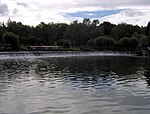Saltford Manor House

The Saltford Manor is a stone house in Saltford, Somerset, near Bath, that is thought to be the oldest continuously occupied private house in England, and has been designated as a Grade II* listed building.The original Norman construction was by William Fitz Robert, 2nd Earl of Gloucester, and was built on an estate owned at the time of the Domesday Book by Geoffrey de Montbray the Bishop of Coutances. It is contemporary with nearby Horton Court which was a prebendary house, therefore it is likely that Saltford had an association with Keynsham Abbey, and has long been associated with St Mary's Church in Saltford.In 2003, Saltford Manor was the winner of a contest sponsored by Country Life to find the "oldest continuously inhabited house in Britain". There were hundreds of entrants, many eliminated because they had been built as ecclesiastical buildings and only become available in the housing market after Henry VIII dissolved the monasteries. Other very old dwellings were eliminated because they are now used as shops or museums. After winning the contest, its resident at the time James Wynn, wrote a history book about the manor entitled The House That Jack Built: The Story of the Oldest Inhabited House in Britain. The book described his love for the site and how he restored it to its current state in 1997. In 2008 Saltford Manor was put up for sale and eventually was sold, on 27 August 2010 for £1,275,000.
Excerpt from the Wikipedia article Saltford Manor House (License: CC BY-SA 3.0, Authors, Images).Saltford Manor House
Queen Square,
Geographical coordinates (GPS) Address External links Nearby Places Show on map
Geographical coordinates (GPS)
| Latitude | Longitude |
|---|---|
| N 51.405277777778 ° | E -2.4536111111111 ° |
Address
Queen Square
BS31 3EL
England, United Kingdom
Open on Google Maps








